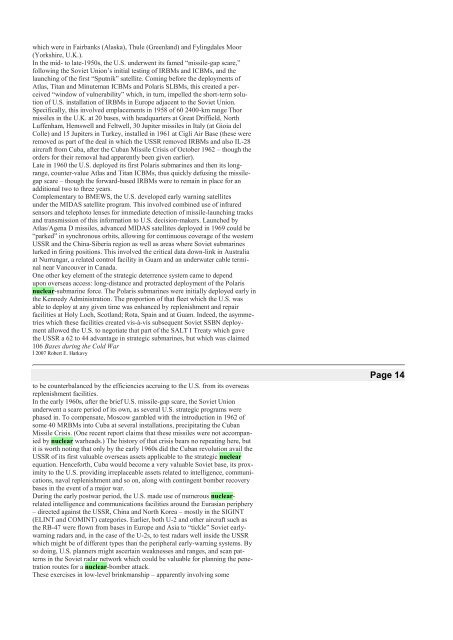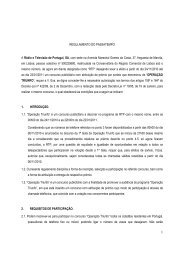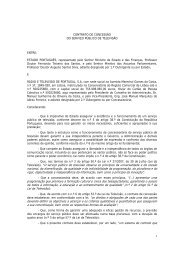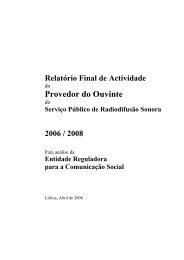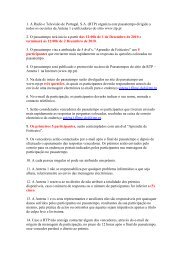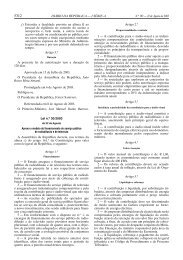which were in Fairbanks (Alaska), Thule (Greenland) and Fylingdales Moor(Yorkshire, U.K.).In <strong>the</strong> mid- to late-1950s, <strong>the</strong> U.S. underwent its famed “missile-gap scare,”following <strong>the</strong> Soviet Union’s initial testing of IRBMs and ICBMs, and <strong>the</strong>launching of <strong>the</strong> first “Sputnik” satellite. Coming before <strong>the</strong> deployments ofAtlas, Titan and Minuteman ICBMs and Polaris SLBMs, this created a perceived“window of vulnerability” which, in turn, impelled <strong>the</strong> short-term solutionof U.S. installation of IRBMs in Europe adjacent to <strong>the</strong> Soviet Union.Specifically, this involved emplacements in 1958 of 60 2400-km range Thormissiles in <strong>the</strong> U.K. at 20 bases, with headquarters at Great Driffield, NorthLuffenham, Hemswell and Feltwell, 30 Jupiter missiles in Italy (at Gioia delColle) and 15 Jupiters in Turkey, installed in 1961 at Cigli Air Base (<strong>the</strong>se wereremoved as part of <strong>the</strong> deal in which <strong>the</strong> USSR removed IRBMs and also IL-28aircraft from Cuba, after <strong>the</strong> Cuban Missile Crisis of October 1962 – though <strong>the</strong>orders for <strong>the</strong>ir removal had apparently been given earlier).Late in 1960 <strong>the</strong> U.S. deployed its first Polaris submarines and <strong>the</strong>n its longrange,counter-value Atlas and Titan ICBMs, thus quickly defusing <strong>the</strong> missilegapscare – though <strong>the</strong> forward-based IRBMs were to remain in place for anadditional two to three years.Complementary to BMEWS, <strong>the</strong> U.S. developed early warning satellitesunder <strong>the</strong> MIDAS satellite program. This involved combined use of infraredsensors and telephoto lenses for immediate detection of missile-launching tracksand transmission of this information to U.S. decision-makers. Launched byAtlas/Agena D missiles, advanced MIDAS satellites deployed in 1969 could be“parked” in synchronous orbits, allowing for continuous coverage of <strong>the</strong> westernUSSR and <strong>the</strong> China-Siberia region as well as areas where Soviet submarineslurked in firing positions. This involved <strong>the</strong> critical data down-link in Australiaat Nurrungar, a related control facility in Guam and an underwater cable terminalnear Vancouver in Canada.One o<strong>the</strong>r key element of <strong>the</strong> strategic deterrence system came to dependupon overseas access: long-distance and protracted deployment of <strong>the</strong> Polarisnuclear-submarine force. The Polaris submarines were initially deployed early in<strong>the</strong> Kennedy Administration. The proportion of that fleet which <strong>the</strong> U.S. wasable to deploy at any given time was enhanced by replenishment and repairfacilities at Holy Loch, Scotland; Rota, Spain and at Guam. Indeed, <strong>the</strong> asymmetrieswhich <strong>the</strong>se facilities created vis-à-vis subsequent Soviet SSBN deploymentallowed <strong>the</strong> U.S. to negotiate that part of <strong>the</strong> SALT I Treaty which gave<strong>the</strong> USSR a 62 to 44 advantage in strategic submarines, but which was claimed106 <strong>Bases</strong> <strong>during</strong> <strong>the</strong> <strong>Cold</strong> <strong>War</strong>İ 2007 Robert E. Harkavyto be counterbalanced by <strong>the</strong> efficiencies accruing to <strong>the</strong> U.S. from its overseasreplenishment facilities.In <strong>the</strong> early 1960s, after <strong>the</strong> brief U.S. missile-gap scare, <strong>the</strong> Soviet Unionunderwent a scare period of its own, as several U.S. strategic programs werephased in. To compensate, Moscow gambled with <strong>the</strong> introduction in 1962 ofsome 40 MRBMs into Cuba at several installations, precipitating <strong>the</strong> CubanMissile Crisis. (One recent report claims that <strong>the</strong>se missiles were not accompaniedby nuclear warheads.) The history of that crisis bears no repeating here, butit is worth noting that only by <strong>the</strong> early 1960s did <strong>the</strong> Cuban revolution avail <strong>the</strong>USSR of its first valuable overseas assets applicable to <strong>the</strong> strategic nuclearequation. Henceforth, Cuba would become a very valuable Soviet base, its proximityto <strong>the</strong> U.S. providing irreplaceable assets related to intelligence, communications,naval replenishment and so on, along with contingent bomber recoverybases in <strong>the</strong> event of a major war.During <strong>the</strong> early postwar period, <strong>the</strong> U.S. made use of numerous nuclearrelatedintelligence and communications facilities around <strong>the</strong> Eurasian periphery– directed against <strong>the</strong> USSR, China and North Korea – mostly in <strong>the</strong> SIGINT(ELINT and COMINT) categories. Earlier, both U-2 and o<strong>the</strong>r aircraft such as<strong>the</strong> RB-47 were flown from bases in Europe and Asia to “tickle” Soviet earlywarningradars and, in <strong>the</strong> case of <strong>the</strong> U-2s, to test radars well inside <strong>the</strong> USSRwhich might be of different types than <strong>the</strong> peripheral early-warning systems. Byso doing, U.S. planners might ascertain weaknesses and ranges, and scan patternsin <strong>the</strong> Soviet radar network which could be valuable for planning <strong>the</strong> penetrationroutes for a nuclear-bomber attack.These exercises in low-level brinkmanship – apparently involving somePage 14
mock raids mounted by U.S. units in Turkey and elsewhere – resulted in someserious incidents in which U.S. ferret aircraft were shot down and <strong>the</strong>ir crewskilled or captured. Some flights originating at Brize Norton in <strong>the</strong> U.K. apparentlytraversed <strong>the</strong> entire Soviet Arctic coastline, emerging at <strong>the</strong> Barents Sea.The area between <strong>the</strong> Caspian Sea and <strong>the</strong> Sea of Azov was also apparently afocal point of U.S. surveillance missions utilizing Turkish and Iranian airspace,some staged originally from West Germany and Cyprus.U.S. use of ground-based SIGINT stations, obviously crucial to variousaspects of nuclear deterrence, dates well back into <strong>the</strong> postwar period. Onesource reported that this had earlier involved some 40 stations in at least 14countries, ranging from small, mobile field units to sprawling complexes such as<strong>the</strong> Air Force Security Headquarters in West Germany. These were said to haveinvolved some 30,000 personnel, with a minimum of 4000 radio-interceptionconsoles operated in such varied locales as nor<strong>the</strong>rn Japan, <strong>the</strong> Khyber Pass inPakistan and an island in <strong>the</strong> Yellow Sea off <strong>the</strong> coast of Korea.Fur<strong>the</strong>r, <strong>the</strong>se COMINT land stations had to be supplemented by numerousairborne and seaborne radio-interception facilities, particularly after Soviet andaligned nations’ military forces switched to VHF radios <strong>during</strong> <strong>the</strong> 1950s, afterwhich adequate coverage demanded getting closer to transmitters and overcomingterrain features such as mountains. At any time, several dozen airborne<strong>Bases</strong> <strong>during</strong> <strong>the</strong> <strong>Cold</strong> <strong>War</strong> 107İ 2007 Robert E. Harkavylistening posts were said to have been in intermittent operation, flying out ofsuch bases as Kimpo Airfield in Korea, Clark Air Force Base in <strong>the</strong> Philippines,and many o<strong>the</strong>rs. Added to <strong>the</strong>se were some 12 to 15 spy ships, such as <strong>the</strong> illfatedPueblo and Liberty, which also presumably required access to foreignports for replenishment.Strategic nuclear forces: missile launchers and platforms15Generally speaking, <strong>the</strong> late <strong>Cold</strong> <strong>War</strong> period saw <strong>the</strong> U.S. and <strong>the</strong> USSR leftwith only minimal dependence on foreign facilities – Soviet dependence wasrelatively less for <strong>the</strong>ir strategic nuclear launchers, involving <strong>the</strong> familiar triad ofICBMs, SLBMs and long-range bombers. Of course, this is not to ignore <strong>the</strong>fact, particularly as it pertained to U.S. forces, that some launchers designated as<strong>the</strong>ater weapons could serve strategic purposes in that <strong>the</strong>ir warheads could havebeen delivered into <strong>the</strong> Soviet Union.All of <strong>the</strong> U.S. ICBMs (450 Minuteman IIs, 550 Minuteman IIIs and a fewremnant Titan IIs which were phased out as <strong>the</strong> new MX-Peacekeeper wasphased in) were housed in silos within <strong>the</strong> continental U.S. – <strong>the</strong>y representedover 2100 accurate warheads. Similarly, <strong>the</strong> Soviet ICBM forces (448 SS-11s,60 SS-13s, 150 SS-17s, 308 SS-18s, 360 SS-19s, 72 SS-25s), of some 1398ICBMs with some 6354 warheads, were sited entirely within <strong>the</strong> USSR.The Soviet SSBN forces (983 SLBMs in 77 submarines, of which 944SLBMs and 62 submarines were under <strong>the</strong> SALT Treaty; and 39 SLBMs on 15submarines were outside it) were based entirely at Soviet homeland bases, in <strong>the</strong>Kola Peninsula area at Polyarny and Severomorsk, and at Petropavlovsk andVladivostok in <strong>the</strong> Far East. No foreign bases were used for refueling, maintenanceor crew changes. By contrast to <strong>the</strong> U.S. only some 15–20 Soviet submarineswere normally away from <strong>the</strong>ir bases; perhaps 10–12 on station at anygiven time.The U.S. SSBN force, which earlier made extensive use of facilities at HolyLoch (Scotland), Rota (Spain) and at U.S.-owned Guam, utilized only <strong>the</strong> firstnamedof <strong>the</strong>se, with its o<strong>the</strong>r three main bases in <strong>the</strong> continental U.S. at KingsBay (Georgia), Bangor (Washington) and Charleston (South Carolina). Thedevelopment of <strong>the</strong> longer-range Poseidon and Trident missiles (with ranges of4000 miles) allowed for utilization of firing stations nearer U.S. bases andfur<strong>the</strong>r from <strong>the</strong> USSR, hence reducing requirements for firing stations in <strong>the</strong>western Pacific (Guam) and in <strong>the</strong> Mediterranean (Rota).Little was publicly known about where <strong>the</strong>se submarines patrolled, but <strong>the</strong>yare thought to have transited to firing stations in <strong>the</strong> Arctic, North Atlantic andNorth Pacific oceans and in <strong>the</strong> Mediterranean Sea, with about 30 percent of <strong>the</strong>force on station on day-to-day alert, and a roughly equal proportion in transit oron training missions. The use of Holy Loch as a forward base (for submarineshomeported at Groton, Connecticut) allowed more to be on station than o<strong>the</strong>rwisewould have been feasible, and it is also to be noted that 400 Poseidon warheadsdeployed on submarines operating out of Holy Loch were designated forPage 15
- Page 2 and 3: This provided the U.S. access to a
- Page 4 and 5: ecame a hot issue within Japan, and
- Page 6 and 7: SpainRotaMajor naval base; also air
- Page 8 and 9: eturn to the link here with aircraf
- Page 13: Molesworth), Belgium (Florennes), t
- Page 17 and 18: III,” 14 stations giving flexible
- Page 19 and 20: wire retaliation strike plan. The n
- Page 21 and 22: Ocean surface surveillance47The U.S
- Page 23 and 24: each site, providing variable cover
- Page 25 and 26: Pinetree LineCanadaBroughton Island
- Page 27 and 28: that is, the Limited Test Ban Treat
- Page 29 and 30: Missile Crisis.68At another level,
- Page 31 and 32: Access for Soviet surface ships.Per
- Page 33 and 34: nel in Libya, whose air force compr
- Page 35 and 36: systems (an exception, of course wa
- Page 37 and 38: Madagascar). There was also a signi
- Page 39 and 40: Aden, Bahrain, Malta, Mauritius, Si


